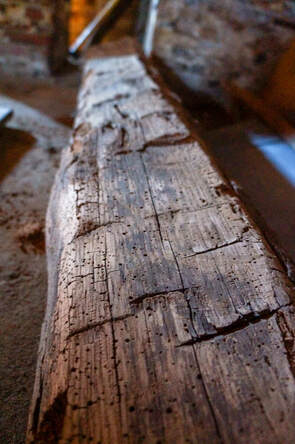 Evidence of the marks of a broad axe. Evidence of the marks of a broad axe. Jim Roache, a fellow curator from the Canton Historical Society, stopped by today. We walked around the building together and near the front door we saw something very special. At the ground, from out of the muddy grass we saw a spring crocus. Purple and yellow with tender green leaves, the crocus greeted us with the joy of another Spring at the Tilden House. That's the thing about what we are now doing. Small things start to become illustrative of a larger story. We now see nails protruding from the beams in what was the kitchen and instinctively we know that at one time, fine herbs once hung from that same spot. We are looking at so many new things everyday. The remarkable thing about this project, is that in doing the work today, the preservation carpenters are using some of the same techniques that have been employed in timber frame construction for the past several centuries. As you walk through the project, the oak timbers are cut with painstaking precision. There is a quality in the craftsmanship that will speak through the ages. The visitor is hard-pressed to find modern materials at this site. Yes, there are a few power tools, but still the old ways are the best ways. The men working at the Tilden are craftsmen, and they take great pride in their work. Chisels and ice tongs liter the work zone, and even scraps and cribbing are employed when needed for a shim or temporary brace. The timbers that are being replaced also tell a story. The marks of the tools that fell the chestnut trees in the 18th century help us see the house in new ways. Gerry O'Doherty pulls out a large bean and shows the marks on the side, "this beam was shaped with a broad axe," he explains. O'Doherty has an instinct that is supported by more than three decades inside really old houses. A natural teacher, O'Doherty shows me the marks, and explains how the tree was felled, shaped, notched and formed to become the beam at our feet. The, O'Doherty goes on to describe the tool itself. Waxing over the description of a goose-neck handle and finely sharpened edge, it is as if David Tilden is describing his work back in 1725. It's a joy to learn so much from a single block of wood. It's been a good season for the preservation crew. The weather has been cooperative, and snow stayed at bay for the most part. Inside the basement, where the bulk of the work has progressed, has stayed fairly tight and has not presented nearly any surprises. From an engineering standpoint, the new oak timbers are impressive. On a recent visit we found that the structural engineer has added three new footings below the oldest section of the house. The new support frame, in many cases, is being sistered alongside existing beams. Visitors to the Tilden in the future will be able to see the new work being done today alongside the preserved work that dates to the original builders of each phase of the house. Soon, the carpenters will be out of the basement, and as the weather gets warmer we will see increased activity outside the house. The transformation is slow and steady. We remain on budget and on a timeline that brings us into the mid-summer for the completion of this phase of work. Each and every time we visit, it is a joy to see and learn more about this place.
1 Comment
|
Preservation BlogThe behind the scenes look at the preservation of this historic structure. Archives
July 2022
Categories |
 RSS Feed
RSS Feed